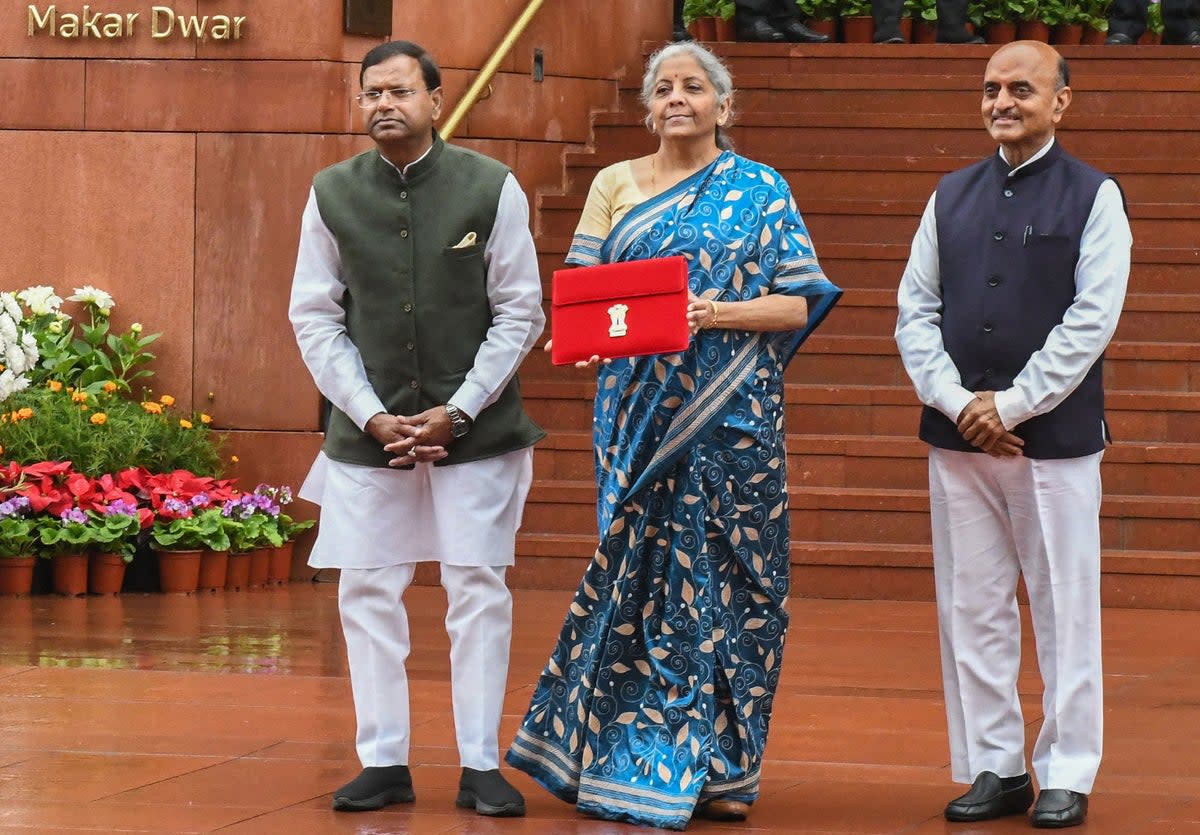India’s Modi avoids major giveaways in final budget before general election

Prime minister Narendra Modi’s government on Thursday presented its last budget to parliament before India heads to the national election slated in May.
Finance minister Nirmala Sitharaman said the interim budget for 2024 will be focused on improving conditions for the poor, women, youth and farmers and the next five years will see unprecedented economic growth in India.
"The economy has undergone a profound transformation," Ms Sitharaman said in parliament as she presented the budget.
Ms Sitharaman unveiled initiatives aimed at enhancing tourism, housing, and adoption of renewable energy. However, the allocated funds for infrastructure development, including roads, ports, and airports, in the world’s fastest-growing major economy fell short of anticipation.
The budget was widely expected to be an economic manifesto to lure voters ahead of the election but there were no big giveaways apart from the for a programme aimed at providing free electricity through rooftop solar projects to 10 million households.
Opposition parties in India criticised the budget for not including the middle and lower-class people and said Ms Sitharaman’s speech seemed more like an election pitch.
Transportation and defence expenditures ranked as the second and third highest expenses for the government. In 2024-25, aside from interest payments, rural expenditures experienced the most substantial rise, increasing by 11 per cent.
What are the key takeaways from the budget?
No changes in income tax which will be biggest income generator for government
There will be no changes in the existing income tax regime for the salaried middle class in both direct and indirect taxes. Taxpayers will not receive any relief as income tax rates and slabs remain unchanged.
"I propose to retain the same tax rates for direct and indirect taxes including import duties," the finance minister said.
The majority of government financial resources originate from borrowings, constituting the primary source. However, the second most significant contributor, or the leading income generator, are income tax revenues.
According to the budget, income tax revenues are projected to comprise 19 per cent of all government resources in fiscal year 2024-2025. Corporate tax is expected to contribute 17 per cent, Goods and Services Tax (VAT) 18 per cent, and borrowings 28 per cent.
High public spending in infrastructure and government schemes
This year, over Rs 10 trillion (£102bn) has been allocated to construct physical assets such as roads and ports, marking an 11 per cent increase from last year. However, this allocation is less than the nearly three-fold annual increases that India has seen since 2019.
Ms Sitharaman announced that the government plans to construct 20 million affordable houses over the next five years, in addition to the nearly 30 million houses already built.
Government spendings announced in Modi government’s flagship development schemes include a rural employment guarantee and programmes to provide safe drinking water along with cash transfers to farmers.
The government will also launch a scheme for housing for the middle class, she said, without providing details.
Reduction in fiscal deficit
The budget has significantly narrowed its fiscal deficit to 5.1 per cent.
The fiscal deficit is the gap between what it earns and spends. It shows the amount of money that the government borrows from the market
This implies reduced market borrowings for the country in a good news, resulting in a rally in India’s bond markets. The finance minister has set a target of 4.5 per cent fiscal deficit by 2026.
Reducing the fiscal deficit will provide reassurance to foreign investors and rating agencies, who have expressed concerns about India’s ability to achieve its target of reducing the deficit to below 4.5 per cent of GDP within the next two years.
Cuts in health and education
Health and education budget allocations in India are often significantly below the country’s actual needs. However, the revised estimates indicate that even these targets were not met in the current financial year.
The government had allocated Rs 1,164bn (£11bn) for education spending but ultimately spent Rs 10,878bn (£103bn), according to Indian Express.
Similarly, in the health sector, it allocated funds for Rs8,895bn (£84bn) but ended up spending only Rs7,900bn (£75bn).
Focus on green energy
In pursuit of achieving ‘net zero’ by 2070, the government said it will extend funding to tap into the offshore wind energy potential, starting with an initial capacity of one gigawatt.
By 2030, the government plans include establishing a coal gasification and liquefaction capacity of 100 million tonnes, which will aid in curtailing imports of natural gas, methanol, and ammonia.
Madhav Pai, Interim CEO of WRI India said the inclusion of green growth as a budget priority in the form of allocations for energy transition, emphasis on battery storage, and green credit announcement “offers encouragement for the environmental sector”.
“We are yet to see the details for how some of this will pan out, particularly the green credit programme, but we are headed in a positive direction,” he said.


